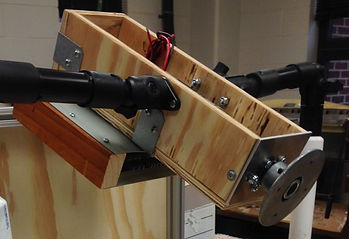Automated Robotic Vehicle Steering System
The main objective was to develop a steering system that could be easily placed in any utility vehicle to control the driving of that vehicle. This was accomplished by building a support structure that securely holds a 24V motor which connects directly to the steering wheel of a vehicle. This motor receives commands from a computer and turns the wheel accordingly.
Abstract
Design Requirements
Table of Contents
System Solution
-
Must be easily secured into the utility vehicle
-
Must adjust to any utility vehicle
-
Has to be able to turn a standard steering wheel left and right
-
Has to be controlled through serial communicaton
-
Had to allow for space for pedal control and integration
I. Security Chair - Aaron Valentine
II. Enclosure - Robert Hoffman
III. Motor & Controller - Donald Ragland
IV. Power Supply - Jung-min Ahn
ELEC 4000 -- Spring 2014
Auburn University
Jung-min Ahn (ELEC)
Robert Hoffman (ELEC)
Donald Ragland (ELEC)
Aaron Valentine (ELEC)
April 31, 2014





Figure 1. The final system solution.
Figure 3. The motor and the motor enclosure shown attached to the motor hub. The enclosure and the motor are being securely held up by the supporting arms of the Security Chair.
Figure 2. This component is securely strapped to the chair of any utility vehicle. It holds the motor enclosure and the motor up to the sterring wheel of the utility vehicle. This device is also known as the Security Chair.
Figure 4. The metal triangle plate with the motor hub attached. The plate is attached to the steering wheel using non slip ratchet tie downs.
Figure 5. The motor and the motor enlcosure attached to the steering wheel using the motor hub and the triange plate. The motor enclosure is shown connected to the ball and socket joints of the supporting arms of the Security Chair.
In the following sections, the subsystems of the device will be discussed. Aaron Valentine will discuss how the security chair was made and secured in the utility vehicle seat. Robert will discuss the enclosure that connects to the steering wheel. The enclosure contains the motor and controller which will be discussed by Donald Ragland. Lastly, Jung-min Ahn will discuss how the device is powered.
The device above meets all of the given requirements. It can be secured in an utility vehicle in 2 and 1/2 minutes. It can be adjusted to account for steering wheels that are in different positions. The device can be powered by a 24V source, and can be controlled through serial connections. The device can turn any standard size utility vehicle steering wheel left or right by controlling the postion or speed of rotation.
